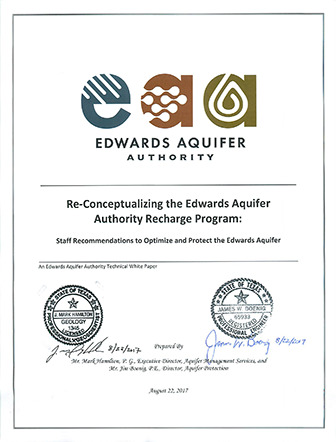Re-Conceptualizing the Edwards Aquifer Authority Recharge Program: Staff Recommendations to Optimize and Protect the Edwards Aquifer

| Author | Mark Hamilton, Jim Boenig |
| Year | 2017 |
| Description | Recharge is defined in the EAA Act as: Increasing the supply of water to the aquifer by naturally occurring channels or artificial means. Based on this definition, the EAA recharge program previously consisted of four recharge dams initially sponsored by the EUWD and Medina County Commissioners Court until calendar year 2004, when participation in the regional Precipitation Enhancement Program (PEP) was added to the program. |
| Publisher | Edwards Aquifer Authority |
| Location | Edwards Aquifer - San Antonio Area |
| Cover | View Download |
| File | View Download |
| Summary |
|
Since the 1970s, the Edwards Aquifer Authority (EAA) and its predecessor agency, the Edwards Underground Water District (EUWD), have operated and maintained four recharge dams located on the recharge zone of the Edwards Aquifer (Aquifer) in Medina County. These structures were constructed by the EUWD on private properties through negotiated easement agreements with landowners within the Nueces River and San Antonio River basins for the purpose of artificially enhancing natural occurring recharge to the Aquifer. The Edwards Aquifer Authority Act (Act) further recognized the aquifer’s recharge capability by granting the EAA the authority to enter into cooperative contracts with political subdivisions of the State of Texas for artificial recharge and to own, finance, and construct recharge dams. To date, however, there have not been any new dams constructed. Over time, with the advent of new technologies and improved understanding of the hydraulic nature of the Aquifer, the EAA “Recharge Program” has evolved beyond the concept of enhanced recharge (or dams) and has developed into a more comprehensive initiative focused on enhancing the available yield of and protecting the water quality in the Aquifer. As a result, today, enhanced recharge is only one of a multitude of tools available to the EAA in its mission to optimize the yield and protect the long-term sustainability of the Aquifer for its beneficial use. Accordingly, this report is presented to communicate the updated scope and priorities of the EAA “Recharge Program” as they have evplved over time. Included is background information on the aquifer and its geologic and hydraulic attributes, summaries of various regional supply strategies and, finally, staff recommendations for the program’s future direction. Background information used to develop this document is derived from previous EAA staff presentations to the Board of Directors (two presented as Technical Briefings and three as reports to the Aquifer Management Planning Committee), which are summarized in the Appendix and available as electronic or hardy copy on request. Recharge is defined in the EAA Act as: Increasing the supply of water to the aquifer by naturally occurring channels or artificial means. Based on this definition, the EAA recharge program previously consisted of four recharge dams initially sponsored by the EUWD and Medina County Commissioners Court until the calendar year 2004, when participation in the regional Precipitation Enhancement Program (PEP) was added to the program. As shown in Figure 2, the EAA Recharge Program has evolved to include a comprehensive set of aquifer optimization and protection strategies. Protection strategies include enforcing EAA Act regulations, monitoring Edwards Aquifer Protection Programs (easements and stormwater basins) sponsoring the EA SRC, canvassing and assessing wells, and conducting water quality research. Management strategies resulting from the EAA Act, such as the EAHCP and Edwards transfers make the use of existing water resources more efficient. Storage strategies, such as the SAWS ASR, are an effective tool to supplement pumping demands during critical periods. These “non-recharge” optimization strategies combined with protective measures that address equally important water quality components add to the long-term sustainability of the aquifer system. In Figures 7a-b, the benefits of current aquifer optimization and protection strategies are summarized and quantified, where possible. In addition to listed existing activities, EAA staff collaborates with regional entities and reviews the technical and legal merit of proposed projects to increase the firm yield of the aquifer. In the future, part of that collaboration could include hosting a workshop to bring regional planners, managers, purveyors, and scientists together to share thoughts regarding new optimization strategies. Although, hosting this type of event would require staff resources and funding to accomplish, it may provide a valuable forum for sharing optimization strategies between interested parties. Note: EAA resources required to review project proposals can be a significant investment due to the complexity of issues and length of time involved. Based on past performance, staff believe that resources are adequate to continue this process without impacting our management fee. This could change, however, if the number or complexity of proposed projects increase. |
Search for Documents
Advance Search
Explore EAA's Scientific Reports
- All Reports
- Overview Studies
- Modeling
- Hydrology and Hydrogeology
- History
- Groundwater Recharge, Recharge Zone
- Groundwater Movement
- Geomorphology and Caves
- Weather Modification
- Geology
- Water Use and Conservation
- Geochemistry
- Water Resources Planning and Management
- Floods and Drought
- Water Quality
- Climatology
- Surface Water / Groundwater Relationship
- Biology
- Springs, Groundwater Discharge
- Archaeology
- RZ Protection
- Aquifer Levels
- Remote Sensing
- Precipitation
